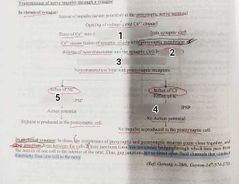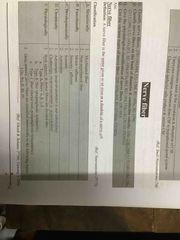![]()
![]()
![]()
Use LEFT and RIGHT arrow keys to navigate between flashcards;
Use UP and DOWN arrow keys to flip the card;
H to show hint;
A reads text to speech;
35 Cards in this Set
- Front
- Back
- 3rd side (hint)
|
Neuroglia And it’s types |
Neuron of CNS supported by several varieties of non excitable cells 1. Astrocytes - supporting framework 2. Oligodendrocytes - Formation of myelin sheath 3. Microglia - phagocytosis 4. Ependyma - circulation and absorption of CSF |
Cells , differ from neuron |
|
|
Nerve fiber |
Name given to the axon or dendrite of a nerve cell |
|
|
|
All or none law |
If the stimulus is in subthreshold in magnitude, the nerve fiber doesn't response and no action potentials is produced. If the stimulus is in above the subthreshold the action potentials is developed |
|
|
|
Refractory period |
The period during which the already excited nerve fiber doesn't response to a second stimulus ARP- begining of one AP when it's impossible to stimulate the other RRP - the time after ARP other impulse can be evoked only when the applied stimulus is stronger |
ARP - Absolute refractory period RRP - relative refractory period |
|
|
Retrograde degeneration Changes occur? |
The changes occur in the cell body and also in the axon proximal to the injury - nucleus pushed to periphery ( cellular edema ) - nissl granules become thin, granular, dispered in cytoplasm ( chromatolysis) - cell body swells ( imbibition of water ) - Golgi apparatus fragments - neurofibrils disappear |
Chromatolysis |
|
|
Neurotransmitter & types |
Chemical agent release from the nerve ending that transmit the nerve impulse from the one nerve to the nerve of effector organs 1. Chemical nature ( amine, AA, others ) 2. Function ( inhibitory, excitatory, both) |
|
|
|
Examples of inhibitory NT |
GABA Dopamine Serotonin Glycine Alanine |
|
|
|
Excitatory NT |
Epinephrine Glutamate |
|
|
|
Both inhibitory excitatory |
Acetylcholine Nor epinephrine Histamine Prostaglandin |
|
|
|
Rapidly acting neurotransmitter |
Acetylcholine Nor epinephrine Epinephrine Dopamine Serotonin Melatonin Histamine GABA Glycine Glutamate Aspartate ATP |
Gaba - gamma amino butyric acid |
|
|
Synapse Classifications |
Site of functional contact between neurons and neurons of other effector cell Structural ( Axosomatic , axodendritic , axoaxonal ) Mode of synaptic transmission ( chemical, electrical) |
|
|
|
Influx of Na+ causes ? Influx of Cl- cause ? |
Depolarisation<AP< impulse is produced in postsynaptic cell Hyperpolarisation <No AP< No impulse in postsynaptic cell |
|
|

Fill the following |
1.presynaptic nerve terminal 2.exocytosis 3.neurotransmitter diffuse through the synaptic cleft 4. hyperpolarisation 5. Depolarisation |
|
|
|
Major level of cns and its functions |
1. Spinal cord level : conduct signal from periphery to the body . Walking movement, control of blood vessels, GI movements 2. Upper Brain level : cerebral cortex. Memory store house . Function associated with lower brain level . 3. Lower brain level : medulla , pons, hypothalamus, thalamus , basal ganglia. It’s control equilibrium, feeding reflex, subconscious control of arterial blood pressure. |
|
|
|
How neurons are classified |
1. ACC. Number of processes : - unipolar: 1 process , invertebrates neuron - bipolar - 2 process . Retina, cochlear & vestibular ganglia 2. ACC to position : UMN LMN 3.acc. Size of axon : Golgi 1&2 4. ACC. Function : motor - cns to periphery , pyramidal cell , anterior horn cell . Sensory - periphery to cns cranial nerve(1,2,8) |
|
|
|
Classifications of nerve fibre |

Back (Definition) |
|
|
|
Properties of nerve fibre |
Excitability Conductivity All or non Law Refractory period Adaptation Summation |
|
|
|
Properties of synapse |
One way conduction Fatigue Synaptic delay Synaptic response inhibition Facilitation summation Occulation |
|
|
|
Properties of sensory receptors |
Excitability Specificity Adaptation Law of projection Law of specific nerve ending Intensity discrimination |
|
|
|
Properties of reflex |
Summation synaptic delay subliminal fringe fatigue facilitation fractionation Inhibition irradiation recruitment reciprocal innervation occlusion habituation |
|
|
|
Excitability |
Nerve cell respond to electrical, chemical, mechanical stimuli but response is always electrical |
|
|
|
Summation Conductivity |
2 or more sub threshold stimulus applied at the same time Propagation of action potential from one site of generation to another |
|
|
|
Nerve impulse conduction ?? |
Continuous conduction in unmyelinated nerve fiber. Along the axolemma Discontinuous In myelinated stimulated only at the nodes of Ranveer . AP jumps from one node to another. |
Axolemma Nodes of Ranveer |
|
|
Hursh factor |
The diameter of mammalian peripheral nerve fibre is 6 .
- conducting velocity is direct proportional to diameter of nerve fibre |
|
|
|
Neurotrophin - Example - source -action , function |
Protein necessary for growth and survival of neuron - Astrocyte , muscle - NT3, NT -4/5 , FGF, NGF - receptor bind with nerve terminal and initate phosphorylation of tyrosine kinases - repair nerve cell, facilitate neural development, growth, important role in maintaining nerve tissue and its transmission |
FGF - fibroblast growth factor NGF - nerve growth factor |
|
|
Wallerian degeneration/ orthograde degeneration Changes occurring |
The process of changes occurring in the axon distal to the injury . - Axon swells and breaks into segments (debris) phagocytes by microglial cells - myelin sheath break down into lipid droplets - Schwann cell begin to proliferate and form a parallel cord - if regeneration doesn’t happen Schwann cell and axon replaced by fibrous tissue |
What will happ in axon , covering sheath , cell of it |
|
|
Transneural degeneration/ anterograde degeneration |
In the cns if one group of neuron is injured and the other group serving the same function may also show degenerative changes. |
|
|
|
Transneural degeneration/ anterograde degeneration |
In the cns if one group of neuron is injured and the other group serving the same function may also show degenerative changes. |
|
|
|
What’s degeneration & types& causes |
Destructive changes occurring in the nerve fibre or nerve cell body . 1. Wallerian ( axon distal to injury) 2. Retrograde ( cell body and segment of axon proximal to injury) 3. Transneural - blockage of blood vessels -crushing and transaction of nerve fibre |
|
|
|
Neuromodulator |
Chemical messenger, which modifies and regulate activities that take place during synaptic transmission. |
|
|
|
Synaptic delay |
It’s a time interval between the arrival of impulse at presynaptic terminal and on set of response in post synaptic terminal. |
|
|
|
Synaptic delay |
It’s a time interval between the arrival of impulse at presynaptic terminal and on set of response in post synaptic terminal. |
|
|
|
Fatigue Synaptic response |
When synapse is rapidly and repetitively stimulated, the number of discharge by the postsynaptic neurons decreases At synapse impulse are received, integrated , discharged. |
|
|
|
EPSP |
-The positive increase in the voltage above the resting neural potential , to less negative value - during this potential the excitability of other neuron to stimuli increased - RMP -65mv to -45mv - EPSP +20 mv |
|
|
|
IPSP |
Negative increase in voltage below the resting neural potential, the more negative value is called IPSP Because of this potential the excitability of neuron to other stimuli decreased. -65 mv to -70 mv IPSP + 5 mv |
Inhibitory post synaptic potential Hyperpolarisation |

